The collision of post-war freedoms with rock ’n’ roll and the birth of the newly waged social phenomenon known as teenagers led to the explosion of dance clubs and events for youth across the country from the late 1950s and through the next decade.
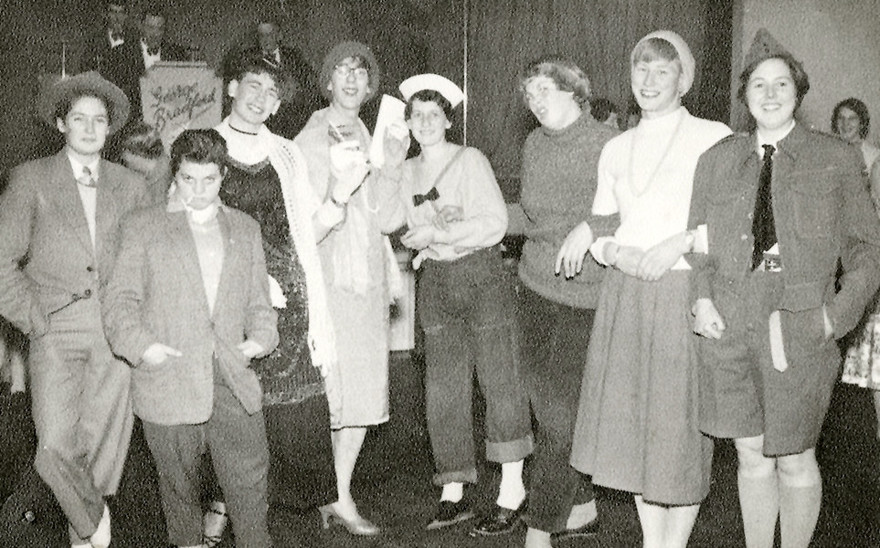
In the days before rock'n'roll we made our own fun: the Christchurch Teachers' College Vice Versa Dance, 1958. - Kete Christchurch
From the earliest days of the 20th century in New Zealand, dancing for adults was a primary source of entertainment, with regular balls, supper dances, dance-and-dance restaurants, and cabarets. All this changed exponentially when Bill Haley, Elvis, Little Richard, Jerry Lee Lewis, and others wound everything up with their wild rocking rhythms, when the surfside Californian sound was born, and when Cliff Richard and the Shadows, The Beatles, and the bands of the British Invasion burst into being.
Teenagers took over the dancefloors. They wanted to move to the music they were hearing on the radio and at the movies. Soon every city and suburban dance band and dance hall featured the top hits of the day for stomping, twisting, youth. Savvy organisers made sure every available town and country club, nightspot, and church hall was a dance hotspot for the rock ’n’ roll youth. Freckle-faced Kiwi rocker Johnny Devlin’s 1958 cover of ‘Lawdy Miss Clawdy’ further set the scene aflame.
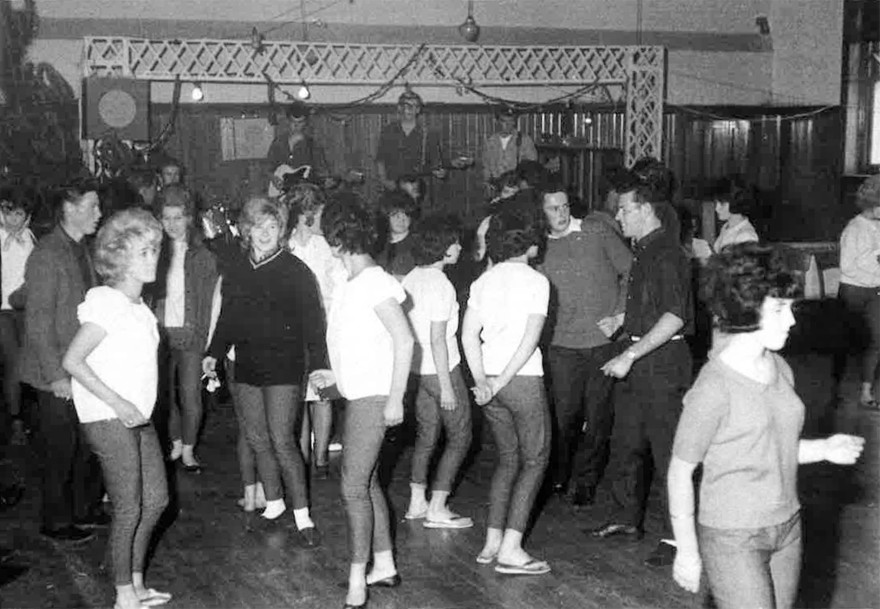
Run by Max Merritt's parents and promoter Trevor King, the Christchurch Teenagers Club began in the Winton Street Hall, and found a steady location at the Railway Hall. - Trevor King Collection
On the Christchurch scene, Max Merritt and the Meteors were kings of one Christchurch dance sector by the end of the 50s, and one of the earliest of the city’s working rock bands. Christchurch musicians were in a prime spot to hear the latest records US servicemen from Operation Deep Freeze were bringing in from 1955 on. Merritt, in the meantime, was staying up all night Saturdays to record hits playing on Sydney’s 2UE radio show to add to his expanding repertoire.
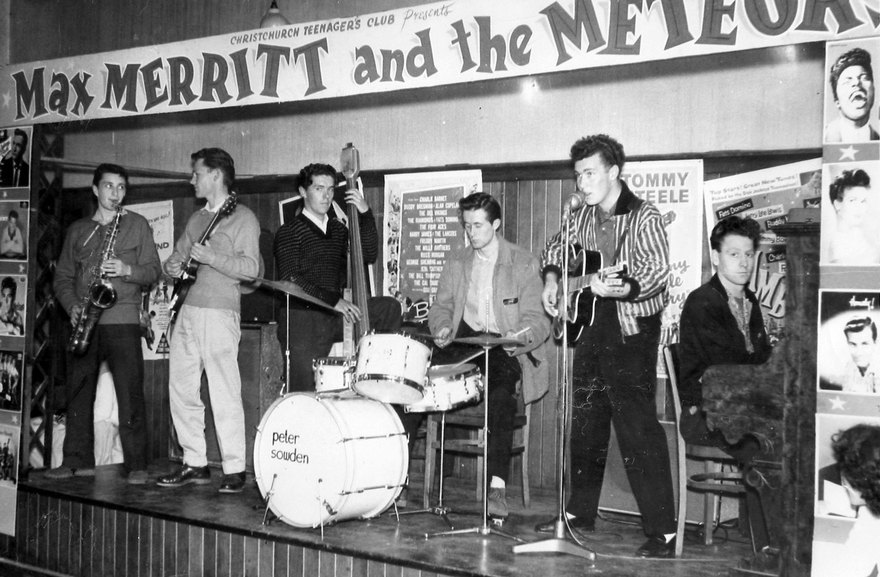
Max Merritt and The Meteors at The Christchurch Teenagers Club, 1958. - AudioCulture Collection
In 1957, promoter and theatre manager Trevor King had organised a meeting of city burghers, increasingly concerned about fractious teenagers and various rock ’n’ roll-associated incidents. Among the attendees were teenage Max and his parents, Jim and Ilene Merritt. It was decided that entertainment for teens was sorely needed, and the outcome was the Christchurch Teenagers Club, the city’s first rock ’n’ roll dance club. It was organised by Trevor King and the Merritts.
The dance was in the Winton Street Hall on Sunday afternoons from 2pm to 6pm with the seminal Meteors on the stage. After noise complaints and neighbourhood grumbling, they moved it to the England Street Hall and on to several other venues, before finding a steadier base at Railway Hall in Carlyle Street.
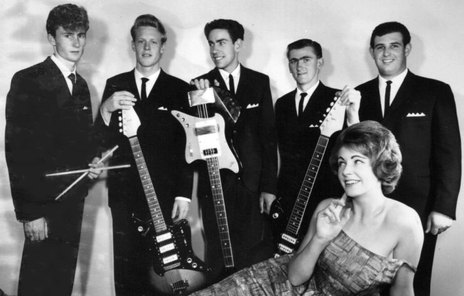
The Playboys (L-R): Graeme Miller, Mark Graham, Brian Ringrose, Dave Martin, Phil Garland, with Diane Jacobs (soon to become Dinah Lee). - Phil Garland Collection
Outlets such as this gave local teens a weekend option other than hanging around being bored or endlessly doing the drive-around circuit of Cathedral Square in their newly earned Vauxhall Veloxes, Zephyrs and Morris 1000s. The band and the dance were so popular that its membership swelled to 1200 at one stage and the organisers added the Hibernian Hall on Barbadoes Street and Wednesday and Saturday dances to the mix.
The Hibernian was well known as a venue that attracted disparate groups of youth bristling for a fight, which the bands always had a prime view of.
“It was great, it was exciting. I was 16 or 17 and I had a band,” Merritt told Graham Reid for AudioCulture in 2005. “I was really innocent and the Hibernian Hall was a bloodbath at times, because you’d have the Māori guys in one corner, the Samoan guys in the other, the seamen who used to come into Lyttelton Harbour in one corner, and the … local ruffians. It was a volatile situation and anything could set it off, but it was exciting, because we were playing rock ’n’ roll and everyone was enjoying it … they liked it dirty and they liked it funky.”
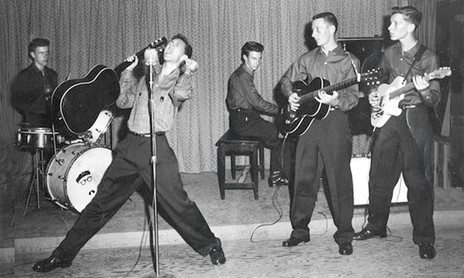
Bobby Davis and the Dazzlers. - Rockhappenz
Merritt told Joy magazine in 1960 that touring rock stars such as Johnny O’Keefe thought that Christchurch was one of the “wildest” towns they played.
Max Merritt and the Meteors might have been kings of the rougher leathers-and-jeans rockers scene, but across town, with a whole coterie of mod-ish fans, was the Avon Theatre’s former ice-cream boy and Xavier College-educated vocalist, Ray Columbus, with his own crown.
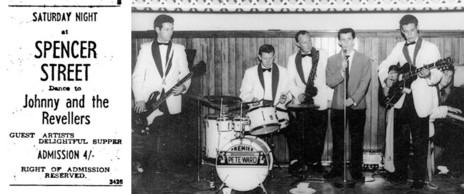
Spencer Street regular Ray Columbus with The Downbeats, his early band in Christchurch. - Rob Carpenter collection
In his 2011 memoir, Ray Columbus: The Modfather – The Life and Times of a Rock ‘n’ Roll Pioneer, Columbus said, remembering: “There are simmering tensions and rivalry between us. They’re the rockers, we’re the Mods, and some of his fans, it turns out, feel pretty tribal towards us.”
This tribal rivalry was played out in real time in 1966 when Bill Gilchrist, a mod, killed rocker Les “Lightning” Thomas in a brawl, but this was still some years off.
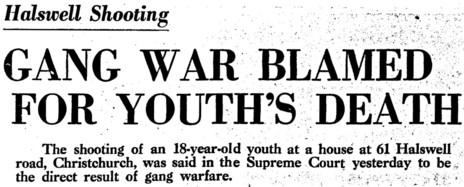
"Gang war" – headline from the Press, 27 April 1967. - Papers Past
The two kingpins were on different musical planets, as Max Merritt described: “I used to play to the funky kids and he played to the well-to-do ones. I played to the working-class ones.”
Light on his tap-dancing feet and fashion-forward, Columbus soon had his band, the Invaders, choreographed in formation and dressed in the spivvy Mod style – collarless suits, skinny trousers, winkle-picker boots and floppy hairdos – à la the Beatles and many of the bands of the British Invasion.
Performers on the black-and-white television music shows, including Columbus’s own Club Columbus, showed the way – hair was growing longer and skirts were getting shorter. Suburban girls at the local dances would ditch the full-circle skirts and teased beehives of the 50s for the new Carnaby Street fashion of shiny vinyl boots, tight miniskirts, and short geometric hairstyles, while boys would shimmy like their “Modfather”.
While these bands were busy establishing their own scenes and followers, the dance scene kicked up another notch. The biggest of Christchurch youth dances in the early 1960s was the weekly Spencer Street Dance in a Catholic parish hall in working-class Addington.
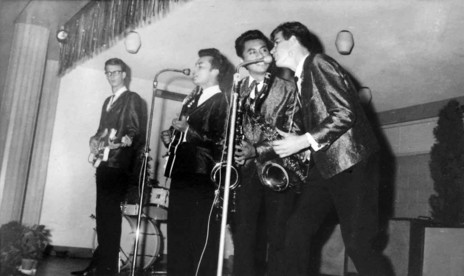
The Chevrons at The Laredo Nitespot (L-R): Paul Bradley, Earl, Dean Whaitiri, and John Storey. - Rockhappenz
Robert Consedine, latterly an author and social historian, and his brother started it in 1960 “mainly for our own entertainment”, he said in a RNZ National Spectrum broadcast about the 1962 scene. The dance’s double purpose was to keep youth off the streets and occupied, while encouraging Catholic young to pair up among their own kind with marriage in mind.
“Being a young person in the early 60s, it was still a fairly structured society and although there were tearaways and occasionally people did things that got them sent to borstal, churches were still fairly dominant.”
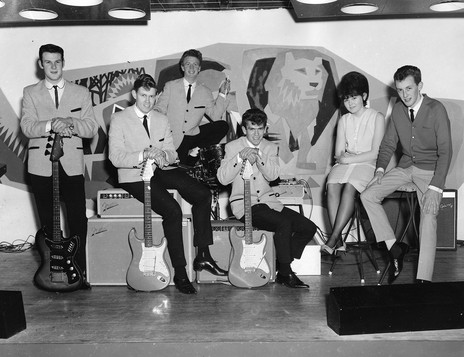
The Diamonds at the Safari Lounge, Tuam Street, Christchurch, 1963-64 (L-R): Ray Messervy, Don Clarkson, Doug Petrie, Dave Henderson, Kaye Bassett, Peter Nelson. - Peter Nelson collection
Spencer Street’s Saturday dances were from 8pm to midnight and at the peak of the event’s three-year run a free bus service picked up patrons from the Square and delivered them back at pumpkin hour to make their way home. For half-a-crown entry you would get to dance and maybe hold your partner close to a rotating order of popular Christchurch bands, with sandwiches, cakes and a hot drink for the four sittings of supper, usually prepared by the parishioner wives of the men on the doors.
“We started doing Top 20 between 11 and 12 at night, and that was when our crowds peaked … The dancefloor was so packed that you could hardly dance. This was a hall that was licensed for 375 and at its peak we had 1200 pass the door quite frequently. Occasionally there’d be a fight – maybe somebody got in who was drunk – and it was quite hard to get to the fight to try and stop it … you had to scrum your way through the crowd.”
After the Meteors and the Invaders with their charismatic front men left for Auckland and Australia in the early 1960s, countless bands formed in their wake with flocks of fans who followed them from venue to venue, and Spencer Street ran out of steam. “When we got down to a couple of hundred, we closed it down.”
It had been run by nuns, wrote Ray Columbus, and was the best place in town to go “to meet beautiful girls. The girls from the three Catholic girls’ schools are there – Villa Maria, St Mary’s and Sacred Heart – so all the guys from Catholic, and even Protestant, schools are there, breaking their necks to get in. Also, the supper by the nuns is legendary.”
Liquor laws were in place till the late 60s, so sneaky drinkers would have to duck outside for a nip as the dances were alcohol-free and strictly policed. Nuns and priests and/or parents would be on the door or in the kitchen, and the local bobbies often timed their check-ins for the supper hour.
As the decade moved on, church-run dances appeared at various denominations across the city from St Anne’s, St Chad’s, St Mary’s and St Matthew’s to St Nicholas’s, St Paul’s, St Peter’s and St Theresa’s, and the Aldersgate Dance at the Durham Street Methodist Church with the Rum Jungle and Anarchy on the bandstand.
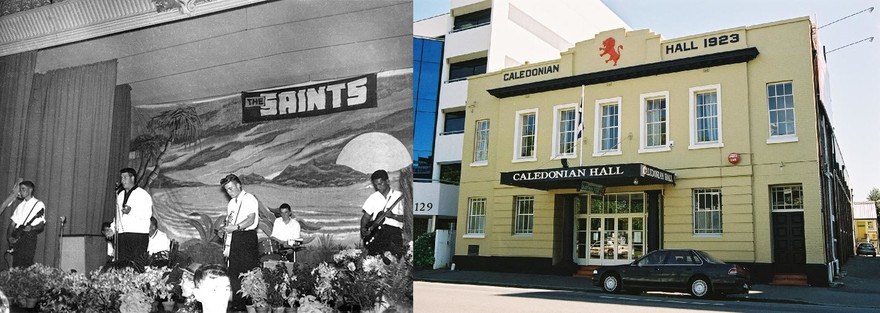
Phil Garland singing with the Saints at Caledonian Hall, Christchurch, 1961; the hall in 2009. - Phil Garland collection; Kete Christchurch.
At the Zodiac Lounge, in Kilmore Street’s Caledonian Hall, patrons paid a six-shilling entry. For three bands a night, they could twist to Chubby Checker’s omnipresent hit or stomp to top Kiwi bands and Australian drawcards, such as Jimmy “the Yakety Sax Man” Sloggett, Col Joy and the Joy Boys or the Deltones. Variety acts were introduced to attract more punters. There were themed dress-up competitions and lucky door prizes, and on any night you might see a fire-eater, comedians, jugglers, magicians, dancing troupes, Have a Shot TV talent-show winners, and Elvis impersonators.
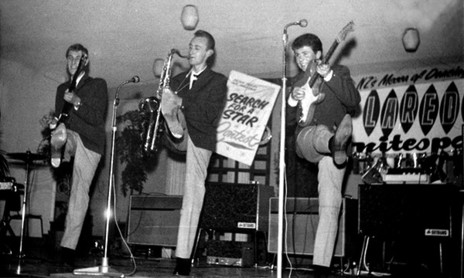
High kicks at The Laredo Nitespot from Johnny Campbell and The Detours - John Campbell Collection
New Zealand’s self-titled “Mecca of Dancing”, the Laredo Nitespot, was a block or two from Cathedral Square between Cambridge Terrace and Gloucester Street. For six shillings, including supper, you could dance to Phil Garland (in his pre-folkie era) and Diane Jacobs in the Playboys, and later the Detours or the Vigilantes, with the house bands backing any touring artists – Howard Morrison, Allison Durbin, Peter Posa, Tommy Adderley, Toni Williams, Ray Woolf, and so on.
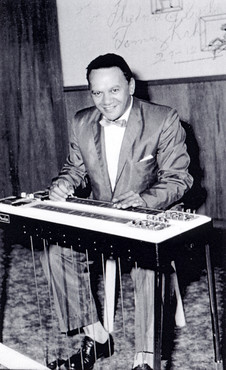
Bandleader and music teacher Tommy Kahi, 27 December 1962 - Mac Mackenzie collection
Out by the beach Tommy and Mark Kahi held sway at the North Beach Surf Club Memorial Hall dances, playing whatever styles of the day that were required. Meanwhile, at the other end of the beach, Johnny Campbell and the Detours became resident band at Surf City, a South Brighton venue in the Pleasant Point Domain Hall.
New Brighton was the city’s only centre open for Saturday trading shopping, and the shopping strip would be crowded most of the day. Surf City and the band took advantage of this factor and rode the wave of their coastal location and the popularity of the California sound with standing-room-only Saturday night gigs and free Saturday afternoon sound-shell concerts.
The Safari Lounge, the Scene and the Mecca Nitespot were in the old Edison Hall building down Tuam Street at various times with bands such as Peter Nelson and the Castaways. There was Snoopy’s, later Aubrey’s, on Chancery Lane, and the Monaco (the “switched on scene for jet set teens”) in the heart of the city advertised all-night action every Sundays from 8pm till 11pm and “Gents a tie please”, with the Revival as house band or Reflections, Next Move, Five Degrees and Les Inwood.
When the King Bee Koffee Kellar with its advertised “Rhythm and Folk Blues” tagline came of age in 1965, changed hands, and morphed into the Stage Door, there was a different mood about. An antipodean Cavern Club, its dark and groovy vibe that evinced hyper-cooldom was personified by its Battle of the Bands-winning residents, Chants R&B (Peter Hansen, Trevor Courtney, Jim Tomlin and Mike Rudd), with their driving British R&B sound.
It was grown-up music for grown-up audiences with a semi-fringe, dress-as-you-dare mood. After Chants R&B joined the musical exodus across the ditch, fans attracted to the burgeoning psychedelic scene stayed on at what then became the Ram Jam or moved on over to the straighter Plainsman on Lichfield Street. With its dress code and soul offerings, it was one of the top nightspots for top local and visiting artists doing pop and soul.
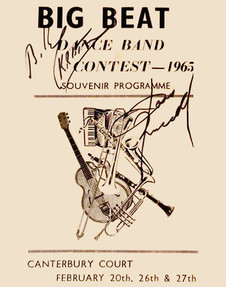
Big Beat Dance Contest, February 1965: Chants R&B won. - Rockhappenz
At beginning of the 1960s, “Kiwi Keith” Holyoake was prime minister, television arrived and both Peter Snell (800m) and Murray Halberg (5000m) won gold at the Rome Olympics. Over the next 10 years pub opening hours were extended to 10 o’clock, the Wahine sank in Wellington Harbour, and New Zealand went decimal. US President “LBJ” Johnson visited New Zealand (a first), a team of Kiwi medics was sent to South Vietnam, and the contraceptive pill became available here. Holyoake may still have been prime minister, but the world was changing rapidly.
For not much longer than a sparky, frenetic decade, squeezed in before the fragmentation of the music scene into the flower-power revolution and multiple other genres, the rock ’n’ roll dances had been all that mattered, focusing the minds and actions of the music-obsessed youth who had time on their hands and money in their pockets.
Most of the buildings where the old Christchurch dance halls, nightspots and rock venues once stood are long gone, devolved into ever-changing business premises over the years or shaken into dust and rubble by the 2010-11 earthquakes.
Stories and pictures remain though, and vivid memories linger in the minds of the dance patrons and note-perfect musicians, still gigging and still using hits from the enduring 60s repertoire at weddings, bar mitzvahs, funerals, anything.